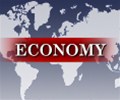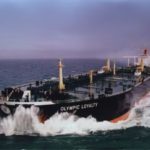Trump’s ‘easy’ war has struck fear into the global economy

In his first speech to the American people as their President, Donald Trump made clear his intentions.
“We must protect our borders from the ravages of other countries making our products, stealing our companies and destroying our jobs,” he said on January 20, 2017. “Protection will lead to great prosperity and strength. I will fight for you with every breath in my body and I will never, ever let you down.
“America will start winning again, winning like never before. We will bring back our jobs. We will bring back our borders. We will bring back our wealth. And we will bring back our dreams.”
The dream had started to take form during the presidential election. In May the previous year he had declared, “we can’t continue to allow China to rape our country and that’s what they’re doing”.
Initially, he took only small steps as he sought a trade deal with China that would allow greater access for American goods (and intellectual property protections for US firms). But by the middle of 2017, things had turned.
The US began an investigation into a range of Chinese policies and practices relating to technology transfer. Tensions simmered before the first anniversary of Trump’s arrival in the White House when he announced safeguard tariffs on goods including washing machines.
Tit-for-tat, the battle between China and the US swirled. Just days before launching a fresh assault in March of 2018, Trump tweeted to his millions of followers that “trade wars are good, and easy to win”.
But more than two years after the first salvos in this trade war with China, both sides are digging in. The financial casualties are growing as signs emerge that neither side knows how this will end.
“We do not want a trade war, but we are not afraid of fighting one,” a spokesman for the Chinese embassy in Canberra told The Sydney Morning Herald and The Age.
“China does not accept any maximum pressure, threat or blackmail. On major issues concerning our principles, we won’t back down even a little bit. China will have to take necessary countermeasures to uphold its core interests and the fundamental interests of the Chinese people.”
Australia, which sent trade emissaries to Beijing last week, can only stand by and urge calm as the two global giants go at each other, with scant regard for the collateral damage.
Liberal MP Andrew Hastie, the chair of the parliamentary joint committee for intelligence and security, summarised the conundrum.
“It is impossible to forsake the United States, our closest security and investment partner. It is also impossible to disengage from China, our largest trading partner,” he wrote in an opinion piece for the Herald and Age.
“This is the central point: almost every strategic and economic question facing Australia in the coming decades will be refracted through the geopolitical competition of the US and the People’s Republic of China.”
That strategic, military and trade competition means the economy now faces the very real threat of the average tariff on Chinese products sold in the US being applied at 10 times the rate it was in 2017, according to Washington’s Petersen Institute for International Economics. The last time they were this high was during the Great Depression.
A 27.8 per cent average tariff could be applied to clothing, shoes, toys and electronics, hitting demand and chilling investment in Australia and abroad.
KPMG found in December that the trade war could result in global equity markets falling by around 10 per cent, costing the Australian economy $423 billion – wiping out more than the value of the Morrison government’s tax cuts over the next decade.
The contagion has already spread.
Global equity, currency and commodity markets were roiled after another series of presidential tweets that kicked off global economic gyrations on Monday. Central banks sliced official interest rates, $80 billion was wiped from the ASX200 in two days and the Australian dollar fell to a 10-year low.
On August 1, after the US Federal Reserve sliced official interest rates for the first time in more than a decade, Trump declared the bank had “let us down” by not signalling a “lengthy and aggressive rate-cutting cycle”.
The following day, after talks between the US and China in Beijing about their ongoing trade dispute ended without any sign of a breakthrough, the US President was back on social media: “Trade talks are continuing, and during the talks the US will start, on September 1st, putting a small additional Tariff of 10 per cent on the remaining 300 Billion Dollars of goods and products coming from China into our Country.”
For the best part of two years, markets had believed that while Trump was engaging in a trade war with China, it would be resolved in a “peaceful” manner. Instead, the unilateral decision from the US to impose more tariffs on Chinese goods on Friday marked a turning point. By Monday, Beijing had retaliated.
As the US recoiled from the weekend’s two tragic mass shootings, China made an announcement it knew would antagonise Trump.
China’s central bank revealed it would allow the national currency to drop below the seven yuan-to-the dollar mark. A few minutes later, it was leaked that American soy and corn farm imports to China would in effect be shut out.
The Commerce Ministry confirmed it the next day.
Trade Minister Simon Birmingham watched on frustrated from Seoul. He had just completed meetings in Beijing on Sunday with Chinese trade officials that had made the first meaningful progress in months.
“I’m an inherently optimistic person first but, you know, these are troubled times,” he said. “There’s no doubt about that in terms of the impact that different trade disputes are having. The rate of growth in global trade has slumped to levels not seen since the global financial crisis.”
The financial one-two punch to the US was immediately recognised as a major economic threat.
Sharemarkets had, until the past week, seemed immune from the economic trouble posed by the trade war. The ASX200 reached a record high on July 30, finally climbing beyond the point it had reached just before the global financial crisis.
The Dow Jones Industrial had reached 27,359 on July 15. It is now sitting more than 1000 points lower and below where it was in early 2018.
Markets across Asia quickly worked out that the trade war discounted by most investors for so long was real. Almost 2 per cent, or $36 billion, was knocked off the ASX200 while the Australian dollar softened. A day later it took another $44 billion hit.
It wasn’t just sharemarkets feeling the pain. Commodity markets also took a battering, including Australia’s most important export: iron ore.
On July 30, a tonne of iron ore was selling at $US121.15. A week later, it had fallen to $US92.80 as concerns grew about the state of the Chinese economy and its demand for the resource. Analysts believe it could settle at $US75, hitting billions of dollars in resource tax takings in the federal budget and the government’s much-touted first surplus in a decade.
While share markets have shown plenty of volatility, bond markets have been more clear-eyed in surveying the current battle. They show worse could be on the way.
The spread between American long-term and short-term bond rates has now inverted (where the interest on three-month government bonds is higher than on 10-year bonds). That points to investors betting the economy is going to deteriorate rather than improve.
Inversions have often occurred ahead of an American recession. The last time it happened was in 2007, ahead of the US falling into the global financial crisis (and dragging down the rest of the world). And it occurred ahead of the tech-wreck recession of the early 2000s and ahead of the 1991 global recession.
S&P Global analyst David Tesher said the round of tariffs announced by Trump at the start of the trade war mostly fell on capital goods. American consumers were largely spared.
“This round of tariffs [however] will affect a majority of consumer goods, rising (sic) the costs of products when households shop at the ‘virtual’ mall,” he said. “If these tariffs remain in place as the shopping season starts for Christmas in as early as October, the US may have a ho-hum holiday.”
The global ratings agency also noted: “The fragile truce between the US and China is now tumbling.”
Central banks moved quickly from Tuesday. India, Thailand and New Zealand all sliced their borrowing rates through the week, while Australia’s Reserve Bank held at 1 per cent despite warning risks to the global economy “remain tilted to the downside”.
The Kiwi central bank, which surprised markets with a half-percentage-point cut just a day after official figures showed NZ unemployment falling to 3.9 per cent, made clear its concerns about the global economic environment.
“Global economic activity continues to weaken, easing demand for New Zealand’s goods and services. Heightened uncertainty and declining international trade have contributed to lower trading-partner growth,” it said.
Since July, 12 members of the world’s 20 largest economies have cut official interest rates. The European Central Bank has signalled it may cut or engage in other measures to boost the eurozone economy, while the Bank of England is also bracing for the fallout from Brexit in late October.
Market analyst IBISWorld said “fear was infiltrating the global economy”.
“It is entering a sustained period of uncertainty, in which Australia may struggle to protect its own economic prosperity,” it said. “As trade negotiations between the United States and China have collapsed, it has become apparent that the economic environment may worsen before it gets better.”
Lawrence Summers, a former economics adviser to US presidents Bill Clinton and Barack Obama, said the collapse in medium and long-term interest rates was ominous.
“We may well be at the most dangerous financial moment since the 2009 financial crisis with current developments between the US and China,” he said. “Markets are now suggesting the highest risk of recession since 2011.”
AMP chief economist Shane Oliver said it would take the threat of a recession in the lead-up to the 2020 US election for Trump to put on the brakes.
“It’s basically about fulfilling a presidential campaign commitment to ‘protect’ American workers from what he regards as unfair trading practices in countries that the US has a trade deficit with – notably China,” he said.
“But recessions and rising unemployment have historically killed the re-election of sitting presidents (Hoover, Ford, Carter and Bush senior) and for this reason we remain of the view that a deal will be reached before the election.”
Trump has continued to argue that it is China that is paying for the tariffs on its imports. Tariff revenue to the US Treasury, paid for by American consumers, is now on track to reach $US100 billion, with much of that being used to aid US farmers who have been some of the hardest hit by the trade war.
In China, the economy has slowed, in part due to firms moving their production facilities to other nations (such as Vietnam) which aren’t exposed to US tariffs. Growth over the past year was 6.2 per cent, its worst performance since the 1991 recession.
The devaluation of the yuan was a recognition that the trade war has made China’s products more expensive, especially in the US.
International agencies such as the OECD and the International Monetary Fund have been warning for some time about the economic fallout from a trade or currency war.
IMF economic counsellor Gita Gopinath said global growth is sluggish and precarious. “But it does not have to be this way, because some of this is self-inflicted.”
Source: Sydney Morning Herald

 Hellenic Shipping News Worldwide Hellenic Shipping News Worldwide, Online Daily Newspaper on Hellenic and International Shipping
Hellenic Shipping News Worldwide Hellenic Shipping News Worldwide, Online Daily Newspaper on Hellenic and International Shipping






















 PG-Software
PG-Software